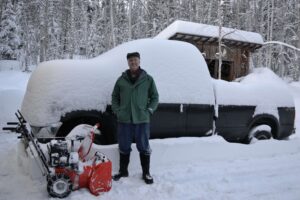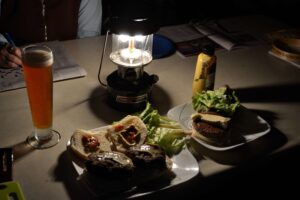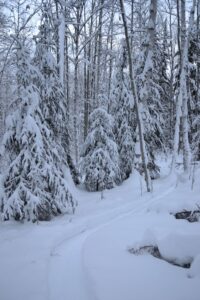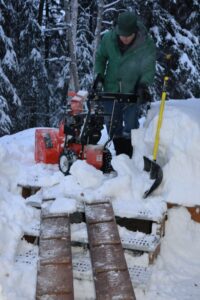I remember when I first learned about global warming (many years ago, now), that a main prediction was that we would see more frequent weather extremes. Talk about predictions coming true with a bang. These days the news seems to perpetually include unprecedented weather events around the world. The periodic unseasonably warm spell—at these latitudes—is okay from time to time, but I know I’d prefer not to live through the big stuff. As if we had a choice…
Here in Interior Alaska we got pummeled over the past week. Two major winter storms came through back to back, breaking historic weather records. Just the sort of thing I’d prefer not to have to experience in person. It was our brief turn in national and international weather news. We’re still digging out.
The first storm began on Christmas Day. Rose and I went out in heavy snow to have dinner with very good friends, but we came home a little early because the snow was not letting up. The roads weren’t plowed and things were getting deep, so we were glad to be tucked in at home that night with a warm fire. We turned the back porch light on a couple times and peeked out to watch the snow deepen. At one point a moose came through and took out the backyard holiday lights—judging from the tracks, we just missed the culprit by moments. It was not a good omen.
It snowed all night, and the storm continued on throughout the next day. All told, we had nine inches of snow, then an inch (!!) of rain. We should not get liquid precipitation in December, but here was an enormous amount of it. This is a major downside of an unseasonable warm snap. I kept poking my head outside all day on Sunday listening to the rain falling. It was downright eery to hear and feel this winter rain falling steadily through day in a slow-motion disaster. It’s going to be very hard on wildlife.
The keys to a subnivean (beneath the snow) existence are the relatively dry and insulating properties of snow. Heavy rain penetrates through the snow some distance but also forms a crust on top. Where snow is shallow, the rain stops at the frozen ground, creating what must be a real hellscape for voles. Then, the frozen crust on top as well as the much harder frozen wet snow (once the rain stops) makes a difficult barrier for the owls, foxes, coyotes, etc. to punch through to eat those tasty voles. And I would not want to be a moose’s leg having to punch through the top ice layer and then having those sharp edges cutting the skin. The depth alone is utterly exhausting (and that’s speaking from the experience of me breaking trail in snowshoes). So I anticipate a lot of winter mortality between now and spring.
On Sunday afternoon when I went out to get firewood in the rain I found the bottom of the wood shed covered in water. It was flowing through the snow, off the roof, and down around the back. This happens sometimes in spring with a heavy, fast melt, but it’s never happened in mid-winter before. Fortunately, I had left the floor strewn with debris as I’d been splitting and removing wood this winter, so by Monday when it was frozen solid there was still enough traction that it wasn’t a skating rink.
On Sunday night, Rose and I expected that as ice accumulated on the trees we’d see power outages. As it got dark, I could hear larger branches breaking off in the forest around the house. And, sure enough, just before 4:00 PM, we lost power. We were prepared for it, with headlamps and a lantern. The wood stove was going, of course, so we cooked dinner on that and stayed up late reading by lantern light and headlamps. We were glad when the power came back on at about 7:00 AM. Thanks, line crews!
When it got light on Monday, the storm was past and it was time to get a bunch of this crap moved before the next storm hit. I had not gone out Sunday afternoon to start, because blowing that much slush is tough and the glare ice left behind would be a bad driveway surface. But it was a risk to wait until it froze up and work on it the next day.
It was bad. The top was a fairly thick frozen crust, but the bottom was just in the final stages of slush firming up. On the bright side, the rain had stopped while the temperature was still high enough to allow the ice on the trees to mostly melt, so there were a lot fewer branches and trees down than there might have been. On the ground, it was not so good. I had to push the snowblower forward and back it up many, many times to create a first swath, and with all that ice going through it sounded like I was blowing rocks. In places I had to use an ice chisel to break things up first. Once I had a first pass cut, I could chisel out half- or third-widths a little easier, but still with a lot of backward and forward pushing and pulling. It was brutally hard work, but by dark it was done. So was I. This was an hours-long, full-body workout. A sauna that night helped ease the stiffness.
Fortunately, it cooled down and stayed there, so the next storm, which began on Tuesday, came down as nice snow. I took Tuesday off from snow shoveling and had a hard time deciding on Wednesday whether I should have fun snowshoeing and break out some of my nearby trails or do my due diligence on snow removal. I did some of each. By the time this storm stopped, we had 15 more inches. Wow. It was exhausting.
The first storm created some December records. And the two storms together pushed Fairbanks’ annual precipitation to a new record. December as a whole gave us 50 inches of snow and ~5.5 inches of water equivalent precipitation. That’s about how much precipitation we get in a normal summer.
The expression “pure as the driven snow” came to mind as I blew this new blanket away on Thursday. It was beautiful snow. It sure beat the crap the last storm had left, although I can’t say I was overjoyed at the quantity of it. It took hours’ more work to clear the driveway again, but I was very glad I’d done it after the first storm.
 Breaking the truck out took brute force and finesse. After digging it out, I had to use an ice chisel to get the driver’s door open. I fired it up and let it run to melt ice. It took about an hour to get the windows scraped clear.
Breaking the truck out took brute force and finesse. After digging it out, I had to use an ice chisel to get the driver’s door open. I fired it up and let it run to melt ice. It took about an hour to get the windows scraped clear.
With so much snow and ice, we have to be concerned with the weight on our roofs. In normal years this is not a problem. We’ve never shoveled off a roof here before. This year, we’re going to clear it. That’s going to take awhile, but I can peck away at it. We’re still below the weight the house is supposed to be able to support. (I’m not sure about the sheds, though.) In thinking about how to get snow off the roof of the house, I realized that we couldn’t just throw it all down on the deck or we’d risk breaking that from excess weight. So before even touching a roof, I decided to clear off the deck.
We have a lot of snow. I did not relish shoveling off the whole deck. Even just keeping a corner of it cleared so I can grill was an effort after these two storms. So I decided to get the snowblower up there to help. First, I cleared a path to the deck, using a shovel and the snowblower. Then I went to get a couple of boards from the wood shed to serve as a ramp. The water in the wood shed had frozen solid, and the boards were frozen in hard. A few whacks with the splitting maul broke them free and I soon had a decent ramp. I took the tire chains off of the snowblower so I wouldn’t chew up the deck surface, and the beast climbed up the ramp like perfectly. Then I just brute forced it backwards and forwards about a million times to clear the large piles of snow.
I am appreciating how effectively a sauna relieves stiffness.
The snowblower has been a real champ. It was not built for what I’ve been putting it through. And for all that ice, I only broke two shear pins.
We’re still waiting for our road to be plowed. They got out after the first storm, but still not yet after the second. The phone was out for five days. After Storm 2, the National Guard was called out to help people stranded in their homes from the ice and snow.
Shoveling roofs will now commence…
P.S. And lo, it did commence; and woe was visited on one forlorn roof monkey. Wishing I could get the snowblower up there, too.




I’d say you should move to less extreme climes, but you may miss out on making Caribou tamales. That would be tragic.
WOW!!
What a royal pain in your heinie!
Glad I’m sitting on mine enjoying your amazing story.
Your dinner photo looks like you’re camping – I guess you kind of were.
Also great to see you in a photo too!
Well, that sounds like fun. Have you ever tried a roof rake? They’re designed for clearing snow off the roof but you wield them from the ground. Our duplex needed raking after heavy snows to prevent ice dams. When we replaced the roof (before selling) we found large gaps between decking boards. These gaps had allowed heat and air to pass through, melting snow that would run down to the eaves and freeze, creating a pool of water along the edge of the roof that would leak back into the house. The house was around a hundred years old and had successive water damage many times. The replacement roof included new decking across the entire surface (an extra $4k expense) but there haven’t been any ice dams since then. We did leave he new owners a roof rake, just in case.
Thought about it, but snow depth/consistency, roof angle, and height all conspire against effective use. In some places it would take about a 50-ft. handle to reach the peak, and without direct downward force it wouldn’t punch through the ice. Up close and personal works, it’s just not fun.